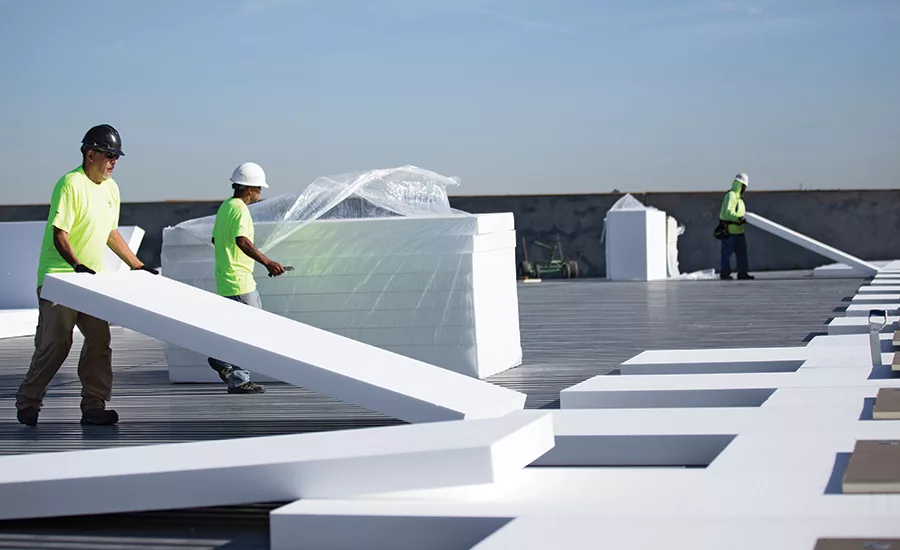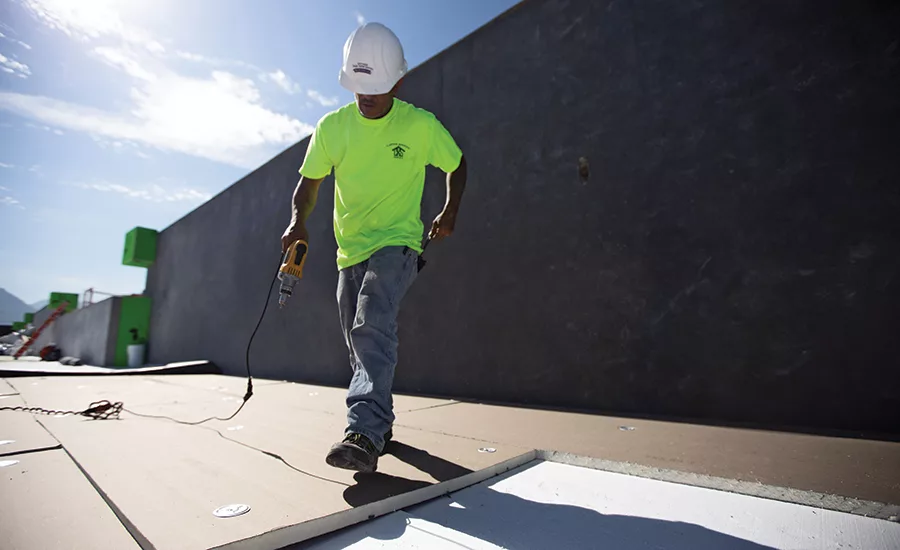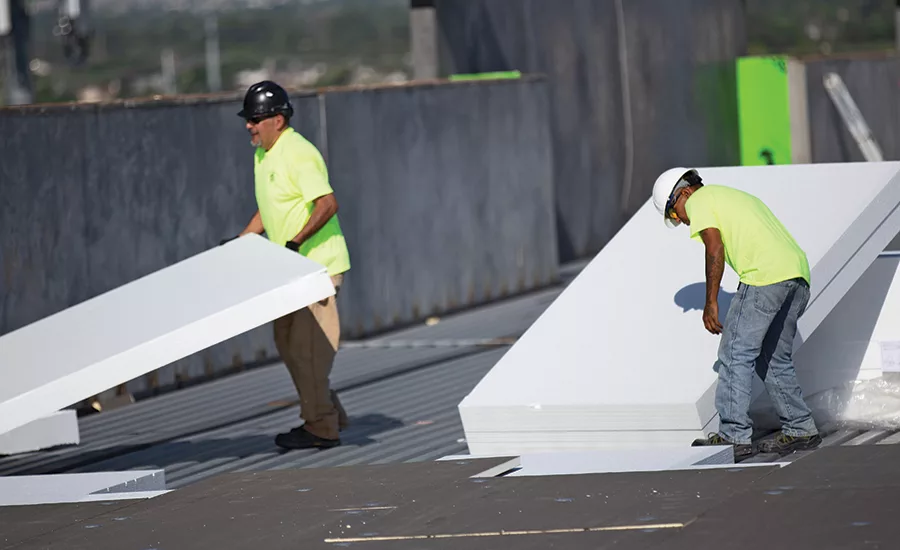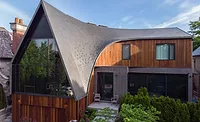Project Profile: Hybrid Roof System with Insulfoam Creates Savings for Utah Business Park

“Because EPS insulation does not experience R-drift, meaning the tendency for a material’s insulating value to decline over time, an R-30 today should be an R-30 roughly 20 or 25 years down the road,” said James Fiscus, estimator with Capitol Roofing Service.

“Because EPS insulation does not experience R-drift, meaning the tendency for a material’s insulating value to decline over time, an R-30 today should be an R-30 roughly 20 or 25 years down the road,” said James Fiscus, estimator with Capitol Roofing Service.

“Because EPS insulation does not experience R-drift, meaning the tendency for a material’s insulating value to decline over time, an R-30 today should be an R-30 roughly 20 or 25 years down the road,” said James Fiscus, estimator with Capitol Roofing Service.
The city of Sandy, Utah, is on the rise. Located just south of Salt Lake City and tucked underneath the shadow of the Wasatch Mountains, Sandy is Utah’s fifth largest city. The mountainside town, home to outdoor sports enthusiasts, is experiencing rapid development, a product of the nearby capital’s growing population and booming economy.
Preparing for the influx of businesses that are taking root, developer Synergy Development set out to build a warehouse and office development in the heart of Sandy. This flex office warehouse will consist of six buildings, each structure ranging from 21,018 to 100,223 square feet in size. Tasked with finding a high-performance and cost-effective roofing system for the business park, the design team employed locally operated Capitol Roofing Service. The roofing company opted for a hybrid roofing insulation with a foundation of expanded polystyrene (EPS) from Insulfoam.
To save further time and money on the job site, the design team took a concrete tilt-up approach for the exterior of each building. The American Concrete Institute (ACI) describes tilt-up construction as “a technique for casting concrete elements in a horizontal position at the job site and then tilting them to their final position in a structure.” This alternative method of construction delivers abundant savings, as tilt-up panels require a smaller workforce and less equipment at install. Contractors installed the hybrid roofing insulation system to two of the six tilt-up constructed buildings.
Hybrid Roofing System Components
A hybrid roof system, utilized for the Synergy business park, consists of a base of EPS insulation topped by one or more layers of polyisocyanurate (polyiso) insulation.
“It’s good roofing practice to have at least two staggered layers of insulation to prevent thermal bridging (or the movement of heat across an object that’s more conductive than the surrounding materials),” explained Daniel S. Barker, owner of Division 7 Specialties, the local Versico Roofing Systems rep for Utah.
Within a hybrid rooking system, EPS’ flexible nature allows Insulfoam to meet an impressive range of compressive strengths for a project, up to 60 psi. Because the customizable material can be precision cut to satisfy virtually any project need, builders can elevate R-values without unnecessary material or added labor costs.
In this particular application, each section of EPS insulation is precision cut to 5.13 inches and provides a compressive strength of 10 psi. After one base layer is applied, a 1.5-inch layer of polyiso insulation with a compressive strength of 20 psi is mechanically fastened on top. With polyiso’s high R-values and EPS’ stability and reliability — EPS’ R-value remains consistent over time — energy is less likely to escape through the roof.
EPS Insulation Delivers Cost Savings
Not only does this two-in-one roofing solution afford high-performance, but the EPS insulation component specifically addressed the roofer’s biggest problem — project cost.
“EPS cost half of what was bid in other insulation options. Even with added fastener costs, the owner still saved double digits per square foot by going with the EPS/polyiso hybrid system,” said Jason Wood, territory sales manager for Insulfoam.
Best R-value Per Dollar
James Fiscus, estimator for Capitol Roofing Service, confirmed the cost-effectiveness.
“Cost was one of the biggest reasons we went with EPS insulation. The owner gives you a budget, and you figure out a way to stay in budget so you can do the job,” Fiscus said. “Whenever you can save on insulation and get the same R-value, that’s a huge benefit.
“Because EPS insulation does not experience R-drift, meaning the tendency for a material’s insulating value to decline over time, an R-30 today should be an R-30 roughly 20 or 25 years down the road.”
With this statement in mind, sourcing an insulation product with a stable R-value is an important consideration for all commercial applications striving to achieve code-required energy efficiency.
EPS Insulation Achieves Code-Required Continuous Insulation
Case in point, today’s energy codes demand not only insulation of a certain R-value, but call on professionals to consider a structure’s overall performance. For example, the International Energy Conservation Code (IECC) requires continuous insulation (ci)—defined as: “Insulation that is continuous across all structural members without thermal bridges other than fasteners and service openings”—within the building framework. Hybrid roofing systems support ci requirements, as their large size afforded by customizable EPS insulation covers a greater surface area with fewer pieces of material, reducing the number of breaks throughout the roofing system. As a result, the complete system will support lower heating and cooling costs for the building’s owners for years to come.
Ample Labor Savings
“EPS also led to labor savings, as the insulation is easy to use and easy to cut,” Fiscus said. “This freed up construction crews to focus on other, more time-consuming tasks.”
EPS’ lightweight properties are largely to credit, allowing fewer workers to lift and maneuver the product with ease, quickly placing one layer of EPS precisely on the roof. Alex Ariano, a foreman for Capitol Roofing Service, echoed this sentiment.
“The EPS insulation is extremely lightweight, so it’s easier for crews to install. And, because of its thickness, less material is needed to get the job done,” he said. “The ease of installation afforded by EPS’ ultra-lightweight nature allows crews to efficiently lay down 6,000 square feet of hybrid roofing system per day, keeping the project on schedule and on budget.”
On top of achieving energy efficiency at cost-savings, the building team was also challenged to work around a small job site. The Synergy project was constrained by a small work area with little room for building material storage.
“EPS again helped, as fewer people could unload more insulation from a single truck,” Fiscus said.
Final System Component: TPO Membrane
The final element of the hybrid roof is the TPO membrane. Manufactured by Insulfoam’s sister company Versico, 60 mil of VersiWeld was laid out over the polyiso, as all three products work compatibly together. Versico used CAV-GRIP 3V’s Low-VOC spray adhesive, which dispenses faster than traditional roll-on adhesives for additional labor advantages. Perhaps most importantly, Versico was able to warranty the complete system.
“The end-user wants products and systems that work well together and can be more efficient,” Barker said. “The owner and architect were looking for a 20-year warranty, and that’s something we’re able to provide with the hybrid system involving different divisions of Carlisle Construction Materials.”
Looking for a reprint of this article?
From high-res PDFs to custom plaques, order your copy today!






